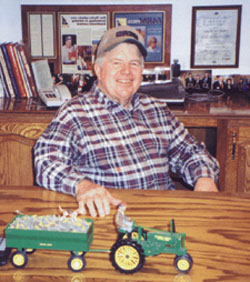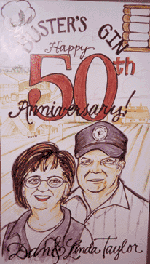|
|
It was late one afternoon
when I arrived at Buster’s Gin outside of Ropesville, Texas. I walked
into the office and was greeted by children chasing one another around
the office and eating their after school snack.
 I
asked for Dan Taylor and was quickly directed to the back of the building
where I could hear someone on the phone laughing and joking. I
asked for Dan Taylor and was quickly directed to the back of the building
where I could hear someone on the phone laughing and joking.
It was Taylor. As
I stood by his office door patiently waiting my turn, he motioned for
me to come in and have a seat.
As I sat there, I
noticed plaque after plaque on the walls of his office. From the Lubbock
Chamber of Commerce to the State FFA Association, Taylor has received
awards from all over the state.
He continued with
his phone conversation laughing at times and then getting very serious,
telling the person on the other end how much he appreciated all he had
done for him and his family.
As he got off the
telephone, we took care of introductions and he asked if I would like
anything to drink. He then proceeded to ask me the usual questions: where
are you from, what is your major, how is school, etc.
I began to fire away
my questions, as he answered each one with a short, thoughtful answer.
 Since
1947, Buster’s Gin has been serving the South Plains cotton industry.
Customers from an 80-mile radius bring in their cotton each year because
of the dedication and superior quality ginning that Dan Taylor provides. Since
1947, Buster’s Gin has been serving the South Plains cotton industry.
Customers from an 80-mile radius bring in their cotton each year because
of the dedication and superior quality ginning that Dan Taylor provides.
Dan Taylor has been
the backbone of Buster’s Gin since 1986. He has solicited nearly
all of the customers he has today and has turned the gin into one of the
most technologically advanced gins in the state.
Dan and Linda Taylor
are the owners and operators of Buster’s Gin and have been on the
South Plains since the 1960s when they both attended Texas Tech University.
“I had never
been to Lubbock until I came to Texas Tech,” Taylor says.
Taylor received his
bachelor’s degree in agricultural education in 1964. Upon graduation,
he began teaching at Lubbock-Cooper High School. He remained at Lubbock-Cooper
until 1975, until he was given an opportunity to work in the cotton industry.
In 1975, Taylor became
manager of the gin with the option to purchase part of the company. Buster’s
Gin was one of the only family operated gins left in the state at that
time and no family member wanted to take over the operation.
By 1986, Dan and
Linda were owners of the gin and eager to make it the best gin in the
state. Taylor quickly updated the gin with the latest technology and equipment.
Taylor has built an educational expansion on his gin to allow civic groups
and local schools and universities to experience the process of ginning
cotton.
The expansion includes
a room overlooking the entire gin so groups can see all of the equipment
in action. It also includes a “mini-museum” with antique gin
equipment.
The greatest satisfaction
from the educational expansion is that Taylor gets to incorporate an educational
outlook on the ginning process.
“By having groups
come out and tour the gin, I still get to use the skills and techniques
I learned when I was teaching,” Taylor said.
The museum includes
a ledger containing the first records of the gin and some equipment from
Lukenbach, Texas. Taylor has collected memorabilia over the years and
finally decided to put it in a place for everyone to see.
“I’ve
had most of this stuff for years and thought that I should let everybody
else get as much enjoyment out of it as I do,” Taylor said.
While taking a tour
through the gin, I asked Taylor where he thought agriculture is headed.
He smiled and laughed, and then became serious.
“There are still
opportunities in agriculture, we just have to work hard to find and make
the best of them. At this point, there must be a source of outside income
for the agriculturist. Insurance rates are going up and it is affecting
every consumer,” Taylor said.
He was also quick
to add that he was probably not the best person to ask this question to,
but was willing to give his opinion.
Taylor eagerly showed me every piece of equipment in the gin. From the
switchboard that runs the entire gin, to the trucks that haul the cotton
to the gin, I got to see every aspect of the operation.
Taylor had the computer
that runs the gin specially designed. It is run with a touch screen, and
monitors every piece of equipment in the gin. With the addition of this
technology, it has helped to increase efficiency throughout the gin.
After the ginning
season is over, every piece of equipment in the gin is physically cleaned.
This cuts down on mechanical problems and prolongs the life of the machine.
With a $2 million press, maintenance and preservation are valuable traits.
Aside from running the gin, Taylor also collects and restores John Deere
tractors. He has had this hobby for about 10 years and has a very impressive
collection.
He took me to see
his collection and I was amazed. He has two barns full of restored tractors
and equipment. How he finds time to have such an extensive hobby will
always astonish me. Taylor said he hopes to one day take some of his tractors
to competitions, providing he can find the time to be away from his busy
schedule at the gin.
Dan and Linda have
three children: DeLinda, Darrell and Davon. All three have degrees in
agriculture, with DeLinda and Darrell being Texas Tech Alumni. Davon graduated
from Texas A & M University.
When talking about
his family, Taylor is very humble and offers information of what his children
mean to him and how proud he is of them as individuals and their achievements.
One thing that Taylor
cannot get enough of, is the competitiveness of the ginning industry.
“That’s
why I like ginning,” Taylor says. “The competitiveness is fun.”
He says that to be
successful and competitive with other gins, volume is necessary. Taylor
says the most drastic thing that changed the harvest of cotton and the
ginning process was the invention of the module builder.
A module is a temporary
bale of cotton. After the cotton has been compacted into a module by the
machine, it is covered with a tarp to stay fresh and ready to gin.
It was developed
to solve the problem that resulted after harvest. Long waits to unload
at the gin stalled harvest until the trucks could return to the fields.
Taylor says that
genetics, chemicals and fertility have also improved the cotton industry.
These factors have helped to produce a better final product.
He has ginned cotton
by hand, with two-row equipment, four-row equipment and eight-row equipment.
The equipment used now is automatic and very consistent.
The Taylors have
also produced a video called “From Field to Finished Bale.”
It describes the process cotton must go through from starting in the field
to finishing in the gin. It is the only video of its type and is 13 minutes
long.
 Nothing
was disrupted to make this video. It was done by a professional and no
shots were set up, no machines were stopped and employees continued their
jobs. Over 48 hours of video was shot to make the video. The Taylors fulfill
requests for the video from all over the nation. Nothing
was disrupted to make this video. It was done by a professional and no
shots were set up, no machines were stopped and employees continued their
jobs. Over 48 hours of video was shot to make the video. The Taylors fulfill
requests for the video from all over the nation.
Every fall, the Taylors host a barbecue for their customers to show their
appreciation. All customers are invited to enjoy a meal and visit with
each other. Videos are continuously played and photo albums are laid out
for customers to observe.
In the future, Taylor hopes to continue with his collection of antique
gin equipment and hopes to start a display showing all the different products
made from cotton.
“If I could
go back to teaching, I would,” Taylor says. “Luckily with the
gin and my educational tours, I get the best of both worlds.”
|
|

